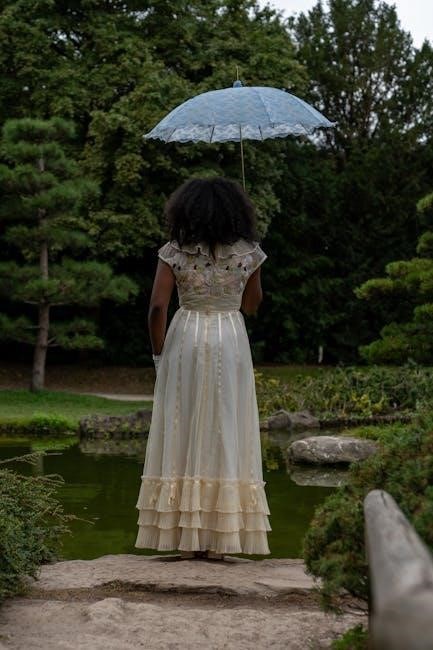witch of blackbird pond pdf
The Witch of Blackbird Pond by Elizabeth George Speare is a captivating historical fiction novel that explores themes of prejudice, friendship, and community. Available as a PDF, study guides and educational resources enhance understanding, making it a valuable tool for homeschooling and classroom learning. The story, set in 1687 Connecticut, delves into the life of Kit Tyler, a young girl accused of witchcraft, and her journey to overcome societal misunderstandings. With its rich historical context and relatable characters, the novel remains a timeless classic in young adult literature.
Overview of the Novel
The Witch of Blackbird Pond, written by Elizabeth George Speare, is a historical fiction novel set in 1687 Connecticut. The story follows Kit Tyler, a young girl from Barbados, who moves to the Puritan community of Wethersfield. Her unfamiliar customs and independent spirit lead to suspicion and accusations of witchcraft. The novel explores themes of prejudice, friendship, and community, highlighting Kit’s struggles to adapt and her bond with Hannah Tupper, a woman misunderstood as a witch. Available as a PDF, the book offers a compelling narrative for readers, with study guides and resources enhancing its educational value. Its rich historical context and timeless themes make it a beloved classic in young adult literature.
Historical Context and Setting
The Witch of Blackbird Pond is set in 1687 in Wethersfield, Connecticut, a small Puritan community. The novel reflects the strict societal norms and religious beliefs of the time, where fear of witchcraft was prevalent. The story draws from historical accounts of English children sent from Barbados to New England, blending real events with fiction. The setting of Blackbird Pond itself symbolizes mystery and isolation, central to the plot. The historical context of witchcraft hysteria in early American society is vividly portrayed, mirroring the Salem witch trials’ atmosphere. Speare’s meticulous research ensures an authentic backdrop, enriching the narrative with cultural and historical depth. This setting is crucial in understanding the characters’ motivations and societal tensions.

Plot Summary and Key Events
The Witch of Blackbird Pond follows Kit Tyler, a young girl accused of witchcraft in a Puritan community. Her arrival sparks suspicion, friendship with Hannah Tupper deepens tensions, and a dramatic trial unfolds, revealing prejudice and misunderstanding.
The Husking Bee and Community Customs
The husking bee is a pivotal event in The Witch of Blackbird Pond, showcasing the close-knit community of Wethersfield. This traditional gathering highlights the importance of collective labor and social bonding. The event serves as a backdrop for Kit Tyler’s introduction to local customs and her growing connections with the townspeople. It also underscores the rigid social expectations and the suspicion directed toward outsiders. The husking bee symbolizes the community’s reliance on shared work and its cautious acceptance of newcomers. This scene sets the stage for exploring themes of belonging, tradition, and the challenges of fitting into a tight-knit society. The event’s significance lies in its portrayal of unity and the subtle tensions beneath the surface.
Kit Tyler’s Arrival and Struggles

Kit Tyler’s arrival in Wethersfield marks the beginning of her journey in The Witch of Blackbird Pond. A young Barbados native, Kit is unprepared for the rigid Puritan customs and harsh New England climate. Her exotic background and unconventional ways spark suspicion among the townspeople, who view her as an outsider. Kit’s struggles escalate as she faces judgment, particularly from Nathaniel Eaton, who questions her suitability as a teacher. Despite her efforts to adapt, Kit’s independence and spirited nature clash with the community’s expectations, leading to misunderstandings and conflict. Her arrival sets the stage for themes of prejudice and the challenges of fitting into a tight-knit society.

The Friendship with Hannah Tupper
Katherine “Kit” Tyler forms a profound bond with Hannah Tupper, a kind but isolated woman accused of witchcraft. Despite the townspeople’s fear and mistrust of Hannah, Kit sees her kindness and seeks her friendship. Hannah, living on Blackbird Pond, teaches Kit about herbs, nature, and survival, offering her a sense of belonging. Their friendship becomes a source of strength for both women, as they find acceptance in each other amidst the community’s prejudice. This relationship highlights themes of loyalty and understanding, as Kit defends Hannah against accusations, showcasing her courage and compassion. Their bond plays a central role in Kit’s journey and ultimately helps her navigate the challenges she faces in Wethersfield.
Major Themes in the Novel
The novel explores themes of prejudice, friendship, and community, highlighting the struggles of misunderstandings and the power of loyalty in overcoming societal judgment and isolation.
Prejudice and Misunderstanding
In The Witch of Blackbird Pond, prejudice and misunderstanding drive the plot, as Kit Tyler faces suspicion due to her unconventional background and behavior. The villagers, steeped in superstition, quickly label her a witch, reflecting the era’s fear of the unknown. This theme is further highlighted through Hannah Tupper, an outcast accused of witchcraft, whose isolation stems from misunderstandings and prejudice. The novel shows how fear and ignorance can escalate into false accusations, damaging lives and relationships. Through these conflicts, the author underscores the importance of empathy and understanding in breaking down societal barriers and overcoming prejudice. The story serves as a timeless reminder of the dangers of judging others based on appearances or rumors.
Friendship and Loyalty
Friendship and loyalty are central themes in The Witch of Blackbird Pond, as Kit Tyler forms strong bonds despite facing mistrust and hostility. Her friendship with Hannah Tupper, an outcast accused of witchcraft, highlights loyalty and trust. Kit stands by Hannah, learning valuable life lessons and gaining a deeper understanding of kindness. Additionally, Kit’s relationship with Prudence Cruff showcases loyalty, as Prudence admires and supports Kit, even when others turn against her. These friendships demonstrate the power of loyalty in overcoming adversity and societal judgment. The novel emphasizes how true friends remain steadfast, providing emotional support and acceptance in challenging times. Friendship and loyalty serve as a cornerstone of hope and resilience in the story.
Community and Isolation
In The Witch of Blackbird Pond, the tight-knit Puritan community of Wethersfield plays a significant role, as its rigid social norms and suspicions often lead to isolation. Kit Tyler, an outsider from Barbados, struggles to fit in due to her differences, highlighting the tension between community expectations and individuality. The community’s fear of the unknown, exemplified by their suspicion of Hannah Tupper, underscores the consequences of being labeled an outcast. Isolation becomes a recurring theme, as both Kit and Hannah are pushed to the fringes of society. The novel explores how communities can both unite and divide, reflecting the challenges of conforming to societal norms while maintaining one’s identity. This dynamic shapes the characters’ experiences and conflicts throughout the story.

Character Analysis
The novel delves into the complexities of Kit Tyler, Hannah Tupper, and Prudence Cruff, exploring their strengths, vulnerabilities, and the bonds that shape their journeys.
Kit Tyler: A Strong-Willed Protagonist
Kit Tyler, the protagonist of The Witch of Blackbird Pond, is a resilient and independent young woman. Hailing from Barbados, her background contrasts sharply with the conservative norms of 1687 Connecticut, making her an outsider. Kit’s strength lies in her courage to challenge traditions and speak her mind, even in the face of adversity. Her resourcefulness and determination to adapt to a new environment showcase her strong will. However, her uniqueness also leads to misunderstandings, as her differences spark suspicion among the community. Throughout the novel, Kit learns to navigate prejudice and grows into a compassionate individual, earning respect and loyalty from those who come to understand her. Her journey highlights the power of resilience and the importance of staying true to oneself.
Hannah Tupper: The Misunderstood “Witch”
Hannah Tupper, a reclusive and kind-hearted woman, is wrongly labeled a witch by the community due to her unconventional lifestyle and deep knowledge of herbs. Living in isolation on Blackbird Pond, she is shunned by the townspeople, who fear what they do not understand. Despite this, Hannah remains compassionate and generous, offering friendship and guidance to Kit Tyler. Her wisdom and gentle nature contrast sharply with the suspicions surrounding her, revealing the unfair judgments she endures. Hannah’s character highlights the theme of prejudice and the consequences of misunderstanding. Her resilience and kindness inspire Kit, showcasing the strength found in those unfairly ostracized by society.
Prudence Cruff and Her Role

Prudence Cruff, the shy and reserved daughter of the wealthy Cruff family, plays a subtle yet significant role in the novel. Her quiet nature often leads to misunderstandings, but she harbors deep loyalty and kindness, especially toward Kit Tyler. Prudence’s strict upbringing and fear of judgment make her hesitant to express herself openly. However, her friendship with Kit and her admiration for Hannah Tupper reveal a desire to break free from societal expectations. Prudence’s character serves as a bridge between the community and the misunderstood individuals, showcasing the challenges of navigating societal pressures while maintaining personal integrity. Her growth reflects the broader theme of overcoming fear and embracing true friendship.

Symbols and Motifs
The novel uses symbols like the mysterious pond, representing isolation and fear, while the red ear of corn symbolizes friendship and loyalty between Kit and Prudence.
The Pond as a Symbol of Mystery
The Blackbird Pond serves as a central symbol of mystery and fear in the novel. Its dark, unmapped waters mirror the community’s collective fear of the unknown, often linked to witchcraft accusations. The pond is associated with Hannah Tupper, the misunderstood woman accused of being a witch, who lives near its edge. For Kit Tyler, the pond becomes a place of refuge, yet it also sparks suspicion, as her presence near it heightens the villagers’ distrust. The pond embodies the tension between isolation and connection, reflecting the broader themes of prejudice and misunderstanding. Its mysterious nature underscores the novel’s exploration of fear and its impact on human relationships.

The Red Ear of Corn and Its Significance
The red ear of corn holds symbolic importance in the novel, representing kindness, generosity, and the complexities of human relationships. Kit Tyler discovers the rare, red-kerneled corn and gifts it to Hannah Tupper, a gesture of friendship and trust. The corn later becomes a pivotal piece of “evidence” during Hannah’s trial, as it is interpreted as a sign of witchcraft. This object symbolizes how misunderstandings and fear can twist simple acts of goodwill into suspicion. The red ear of corn also highlights the themes of prejudice and the consequences of unchecked accusations, serving as a reminder of the novel’s exploration of human frailty and judgment.

Educational Resources and Study Guides
Educators and students can access study guides, teacher manuals, and online resources for The Witch of Blackbird Pond. These tools provide detailed analyses, discussion prompts, and activities to deepen understanding of the novel’s themes, characters, and historical context. PDF versions of these guides are widely available, offering convenience for classroom use and independent study. They are invaluable for fostering critical thinking and engagement with the story’s timeless lessons about prejudice, friendship, and community.
Study Questions and Answer Keys

Study questions and answer keys for The Witch of Blackbird Pond are essential tools for understanding the novel’s themes, characters, and plot. These resources, often available in PDF format, provide students with guided inquiries to analyze key events, such as Kit’s arrival in Wethersfield or her friendship with Hannah Tupper. Questions may focus on character motivations, thematic elements like prejudice and loyalty, and the historical context of 17th-century Connecticut. Answer keys offer clear explanations, helping students assess their comprehension. Educators can use these materials to create engaging discussions or assignments, while students benefit from structured guidance to deepen their analysis of the novel. These resources are invaluable for fostering critical thinking and preparing for exams or class discussions.
Short Answer Test Questions
Short answer test questions for The Witch of Blackbird Pond are designed to assess students’ comprehension of key themes, characters, and plot points. These questions, often included in PDF study guides, focus on specific events like Kit’s trial, her relationship with Hannah Tupper, and the community’s reaction to her. Students may be asked to explain the significance of the red ear of corn, the role of superstition in the story, or how Kit’s background influences her interactions. Such questions encourage critical thinking and the ability to connect details to broader themes. They are invaluable for evaluating understanding and preparing students for in-depth discussions or exams, ensuring a thorough grasp of the novel’s elements.
Literature Guide for Homeschoolers
A literature guide for homeschoolers studying The Witch of Blackbird Pond provides structured lessons and activities tailored to individual learning. These guides, often available in PDF format, include discussion prompts, vocabulary exercises, and comprehension questions. Homeschoolers can explore themes like prejudice, friendship, and community through guided analysis. Activities may involve creating character maps, writing reflective essays, or researching historical contexts. The guide also offers tips for parents to facilitate meaningful discussions and connect the novel to broader curriculum goals. By incorporating hands-on projects and critical thinking exercises, homeschoolers can deepen their understanding of the story and its relevance to real-life issues, fostering a love for reading and learning.
Historical and Cultural Significance
Set in 1687 Connecticut, The Witch of Blackbird Pond reflects witchcraft hysteria and colonial tensions, offering insights into early American societal fears and cultural shifts.
New England History and Its Influence
The novel is set against the backdrop of late 17th-century Connecticut, a time when New England was heavily influenced by strict Puritan values and the fear of witchcraft was rampant. This historical setting shapes the community’s actions and beliefs, contributing to the witchcraft hysteria depicted in the story. The Puritan society’s suspicion of outsiders and adherence to rigid social norms are central to the plot, as seen in Kit Tyler’s struggles. The novel reflects the real-life tensions of the era, mirroring events like the Salem witch trials, which occurred around the same time. This historical context adds depth to the narrative, illustrating the societal fears and prejudices of early New England.
Witchcraft in Early American Society
Witchcraft in early American society was deeply intertwined with fear, superstition, and religious beliefs. During the 17th century, the Puritan community viewed witchcraft as a threat to their strict moral order, often blaming it for unexplained events or misfortunes. This fear led to the witch trials, where accusations were frequently fueled by suspicion, misunderstanding, and social tensions. The novel reflects this era’s witchcraft hysteria, as seen in the community’s distrust of outsiders like Hannah Tupper. The societal fear of witchcraft not only shaped the characters’ lives but also highlighted the dangers of unchecked fear and false accusations, mirroring real historical events like the Salem witch trials.
Teaching the Novel
Engage students with discussions on themes like prejudice and friendship, fostering empathy and critical thinking through interactive activities and multimedia resources.
Visual Aids and Design Tools (e.g., Canva)
Visual aids and design tools like Canva can enhance the teaching of The Witch of Blackbird Pond. Teachers can create engaging lesson plans, character maps, and historical timelines to visualize key events. Designing infographics about 17th-century New England or the witch trials can deepen students’ understanding. Canva’s templates allow educators to craft visually appealing presentations, making complex themes like prejudice and friendship more accessible. Additionally, students can use these tools to create projects, such as illustrating scenes from the novel or designing book covers, fostering creativity and comprehension. These resources make the story immersive and interactive, catering to diverse learning styles and enriching the educational experience.
Collaborative Learning Opportunities
Collaborative learning opportunities enrich the study of The Witch of Blackbird Pond, fostering engagement and teamwork. Group discussions encourage students to explore themes like prejudice and friendship, while role-playing scenes from the novel helps students connect emotionally with characters. Peer teaching allows learners to explain plot points or historical context to one another, reinforcing understanding. Collaborative projects, such as creating timelines or community maps, promote problem-solving and creativity. These activities not only deepen comprehension but also encourage empathy and critical thinking, making the learning experience more interactive and meaningful. Collaborative efforts help students see multiple perspectives, enhancing their appreciation for the novel’s complex themes and historical setting.
Integrating the Novel into Curriculum
Integrating The Witch of Blackbird Pond into the curriculum offers a rich educational experience. Teachers can align the novel with literature, history, and social studies standards, exploring themes like prejudice, community, and historical contexts. The story’s setting in 1687 Connecticut ties into early American history, making it a valuable resource for interdisciplinary learning. Cross-curricular activities, such as writing essays on tolerance or creating historical timelines, enhance student engagement. The novel’s accessible language makes it suitable for middle school and high school students, fostering discussions on empathy and morality. By incorporating this text, educators can connect literary analysis with broader educational goals, providing students with a comprehensive understanding of both the story and its historical significance.
Author and Legacy
Elizabeth George Speare, a celebrated American author, crafted compelling historical fiction for children. Her works, including The Witch of Blackbird Pond, have earned critical acclaim and awards.
Elizabeth George Speare’s Background
Elizabeth George Speare, born in 1908 in Melrose, Massachusetts, was a renowned American author of children’s historical fiction. She developed a passion for storytelling and history during her childhood, influenced by her father’s tales of the past. Speare attended Boston University and later taught high school English, experiences that shaped her writing style and understanding of young readers. Her novels often explored themes of courage, prejudice, and resilience, drawing inspiration from New England’s history. The Witch of Blackbird Pond remains her most celebrated work, earning the Newbery Medal in 1959. Speare’s ability to weave historical accuracy with compelling narratives cemented her legacy in children’s literature.
The Novel’s Impact on Young Adult Literature
The Witch of Blackbird Pond has left a lasting impact on young adult literature, earning widespread acclaim for its historical depth and relatable themes. The novel’s exploration of prejudice, friendship, and resilience resonated with readers, making it a timeless classic. Its vivid portrayal of colonial life introduced many young readers to historical fiction, inspiring a deeper appreciation for the genre. The book’s accessibility and emotionally charged storytelling have made it a staple in educational curriculums, fostering critical thinking and empathy. By addressing complex social issues through a compelling narrative, Speare’s work has influenced countless authors and remains a cornerstone of young adult literature, continuing to captivate readers with its enduring message.
The Witch of Blackbird Pond captures the essence of courage, friendship, and overcoming prejudice, teaching readers about the consequences of fear and the power of understanding. A timeless tale for all ages, it encourages empathy and kindness, leaving a lasting impression on young adult literature and beyond.
Final Thoughts on the Novel’s Relevance
The Witch of Blackbird Pond remains a compelling and thought-provoking novel, offering timeless lessons on prejudice, empathy, and the importance of understanding others. Its historical setting provides a vivid glimpse into 17th-century New England, making it a valuable educational resource. The story’s themes of resilience, friendship, and standing up for what is right continue to resonate with readers of all ages. By exploring the complexities of human behavior, the novel fosters critical thinking and self-reflection. Its enduring popularity underscores its relevance in contemporary discussions about inclusion and justice, ensuring its place as a cherished work of young adult literature for generations to come.
Encouraging Further Exploration
Exploring The Witch of Blackbird Pond offers a rich opportunity to delve into themes, characters, and historical contexts that remain relevant today. Readers are encouraged to analyze the novel’s portrayal of prejudice and resilience, reflecting on how these issues persist in modern society. Further exploration can involve researching the historical background of witchcraft in early America or examining how the novel’s themes align with contemporary discussions on inclusion and justice. Engaging with study guides and discussions can deepen understanding, while creative projects, such as writing a modern-day adaptation, can inspire personal connection to the story. This timeless tale invites readers to think critically and empathetically, making it a valuable addition to any literary journey.